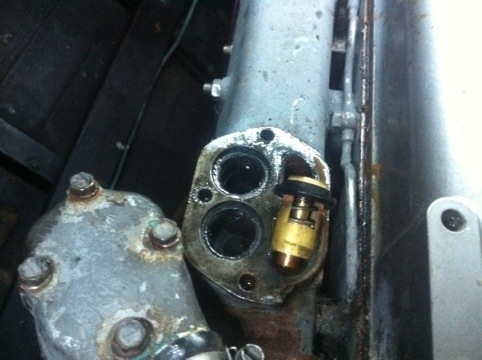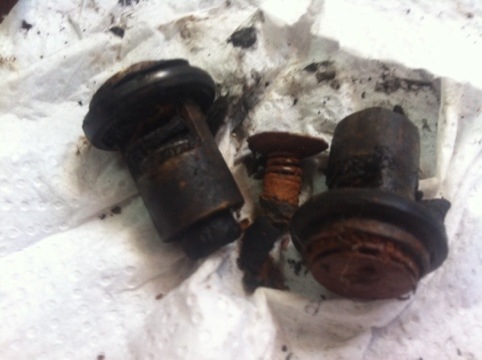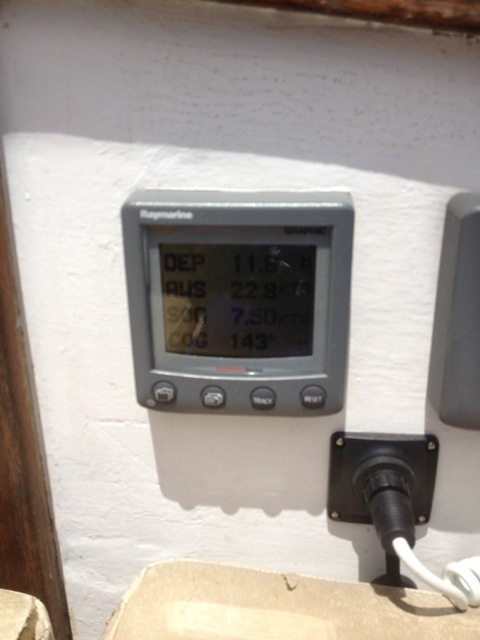Someone once told me there are three types of problems in the world:
Category #3 problems need money to solve.
Category #2 problems need time to solve.
Category #1 problems need both time and money to solve.
Aboard ERIK, we are starting to have a number of Category #3 problems, and some of them are escalating themselves to Category #2.
The first one popped up on our way to Georgetown to do some grocery shopping….
It had been blowing 20 to 30 knots from the northwest for a few days, and we were snugged up in Dark Hollow on West Arm. With a lull in the weather and an early ebb tide, we raised anchor and set off for Georgetown, about 3nm away. We cleared Shag Rock then Saltpan Point, then the engine water alarm came on!
Quickly killing the engine, we set staysail, mizzen and main and started sailing toward the Georgetown jetty on the last of the ebb tide. The wind got up, and we picked up speed, first doing 4, then 5, then 6 knots. Heeling over and roaring toward the jetty, we luffed up and dropped the staysail and mizzen and did a pass, past the jetty, under main alone. The wind was gusting 25kts from the northwest and the only space was on the windward side of the jetty. Not keen at making the jetty with no escape route we decided to sail close, drop sail, fire the engine up, make the jetty, and put the engine in hard reverse to kill our speed then kill the engine before it overheated again. We tacked out and back up river, then gybed around and lined up our approach. As luck would have it, the wind died on the approach and dropping the sail wasn’t as rushed as expected. Then engine fired, didn’t go into alarm and we tied up against the jetty without a problem.
Lis and I went below and had a look at the engine. It’s a seawater cooled Yanmar 3QM30. We had water coming in, the inlet strainer wasn’t clogged, the impeller housing was cool and there was water coming out with the exhaust. The engine temperature gauge wasn’t working, so no information there… We had a look at the manual and found that the thermostat, when it doesn’t open, it redirects water from the inlet to the exhaust, bypassing the engine water circuit. If ours wasn’t opening, the water would come in and go out, but the engine would eventually overheat like ours was. Time to check the thermostat.
Lis put her engineers cap on and got stuck into disassembling the thermostat housing. We had a spare, and there’s only room for one bum in our engine room, so I took the boys into town and started shopping.

the replacement thermostat ready to go in

the old thermostats, clearly stuffed
We found two thermostat units in the housing, but we had only one spare. Lis put the replacement part in after cleaning all the grunge out and reassembled, and we haven’t had a problem since. We now need to replace the spare, and find out if two thermostats are supposed to be in there, as the manual for the engine clearly shows only one. Money required for the spare, none available: Category #3 problem.
Raising the anchor on an electric windlass without an UP switch…
After shopping, we set off upriver with the incoming tide to make for Devils Elbow. The northwesterly had built to a steady 25kts, occasionally gusting to 30 or so, and whitecaps covered
the water north of Middle Island, and Long Reach had white spray further south. With the engine in neutral and mizzen and staysail set, we (carefully!) gybed around the north cardinal marker at the head of Long Reach and surfed off downwind. The waves built a little the further south we got, but were never a problem. In fact, we had a great sleigh ride down, waves hissing as they broke either side of us.
After a gusty reach down Moriarty Reach, we rounded up into Devils Elbow and poked our way through the moorings to drop anchor. All went well until Lis went to take in a bit of slack and found the UP foredeck switch had ceased to be. It was an ex-switch, now singing with the bleedin’ choir invisible.
We have a Muir Cheetah electric anchor winch, with foredeck foot switches for up and down, and cockpit switch for same, and another in the forepeak. No shortage of alternative means to take in chain, but using the cockpit switch while watching Lis for hand signals, steering the boat and making throttle and gear changes (which on our boat requires bending down) made me feel like a one armed juggler.
The switches all go into a relay that switches the positive feed from the batteries to the winch. A check with multimeter revealed that 12v was coming into the switch, but not out. Switch problem, not a relay problem. Time for a new anchor foot switch, and the second Category #3 problem for the day.
Making Launceston
We got up early for the tide and ate breakfast on the go. As forecast, the wind had swung to the south and was roaring through under Batman Bridge against the incoming tide. ERIK is pretty solid, but I thought we might get wet on this leg. I needn’t have been concerned, she took all in her stride without fuss and we went under the Bridge, through the whirlpools and boils, and then banged our way down past Swan Point. Once the river narrowed the wind against tide was less of an issue, and we had a quiet trip up to our designated spot at Launceston Seaport.
With the rain clouds all around, we had a surprise visit from Lachlan, eldest son of Gregor; an old work mate of Lis’s from the AMC. With plenty of charge in the batteries we opted to save a bit of money and not connect to shore power. Launceston Seaport’s prices are such that if you are light on your power usage and use a small diesel or generator for charging, it’s cheaper to not plug in.
Later that night we had our final alarm for the day. We had just got the kids into bed and Lis was on the phone when I suddenly realised it was slightly downhill toward the bow of the boat. Walking up and down a few times didn’t dispell my impression, and I tapped on a fore/aft level gauge for a reading. 1 degree, then 2, then 3 degrees. It was getting worse quickly! I checked the bilge; no water. I leapt off the boat and sure enough, even though it was dark, I could see the antifoul on the rudder, three or four inches clear of the water! The bow was sinking! Arghhh! I leapt aboard and grabbed the torch, and decided to switch the sounder on to see how far she would sink before she settled into the mud. The sounder warmed up and went into alarm immediately! One meter of water, then less! We were already aground! Arghh!
Taking a deep breath or three, I went out and shone the torch around the Marina. Sure enough, great expanses of mud were making themselves visible above the water, more and more as the seconds passed and the water ebbed out off the flats. ERIK settled into the mud, slightly bow down. Realising that she was going to be okay, I checked her lines to make sure she wasn’t going to hang herself up by them and went below to shut all the seacocks. I didn’t want mud forcing its way into any inlets.
Sigh, what a day. Time to go to bed and think about what we could for Lis’s birthday the next day… My next Category #3 problem.



